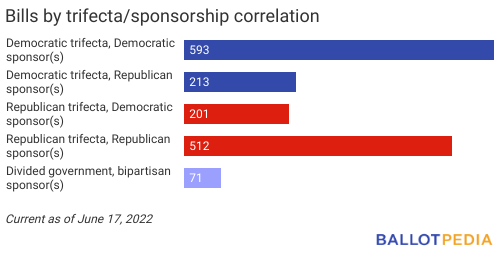Here is our weekly round-up on election-related legislation. In it, you’ll find the following information:
- Noteworthy bills: Here, we identify and report on the contents and legislative status of noteworthy bills.
- Recent activity: Here, we report on the number of bills acted on within the past week.
- The big picture: Here, we look at the bills in the aggregate.
- Legislative status: How many bills have been introduced, voted upon, or enacted into law?
- Concentration of activity: What states have seen the highest concentration of legislative activity?
- Partisan affiliation of sponsorship: How many bills have been sponsored by Democrats vs. Republicans?
- Subject: What subjects are most commonly addressed in the bills?
Noteworthy bills
This part of our report highlights recent activity on specific noteworthy bills. A bill is noteworthy if it meets one or more of the following criteria:
- It has been enacted into law.
- It is poised to be enacted into law.
- It is the subject of significant debate in the legislature.
- It is the subject of significant commentary by activists, journalists, etc.
RI H7732: This bill requires the secretary of state to conduct cybersecurity assessments of election systems, including voter registration systems, voting equipment, mechanisms used to transmit election results, and electronic poll books. This bill also establishes an election systems cybersecurity board to review the assessments conducted by the secretary of state and to commission third-party assessments, with the board required to report on its findings no later than 2 months prior to every statewide primary election. This bill also requires the secretary of state to offer annual training on cybersecurity best practices to local election officials.
Legislative history and status: On April 7, the state House passed the bill 64-3. On June 9, the state Senate unanimously approved the bill. Gov. Daniel McKee (D) signed H7732 into law on June 15.
Political context: Rhode Island is a Democratic trifecta, meaning that Democrats control the governorship and majorities in both chambers of the state legislature.
Recent activity
Since June 10, 69 bills have been acted on in some way (a 38.0 percent increase as compared to last week’s total of 50 bills). These 69 bills represent 2.7 percent of the 2,518 bills we are tracking. Of these 69 bills, 30 (43.5 percent) are from states with Democratic trifectas, 9 (13.0 percent) are from states with Republican trifectas, and 30 (43.5 percent) are from states with divided governments.
The bar chart below compares recent activity on a week-to-week basis over the last eight weeks.
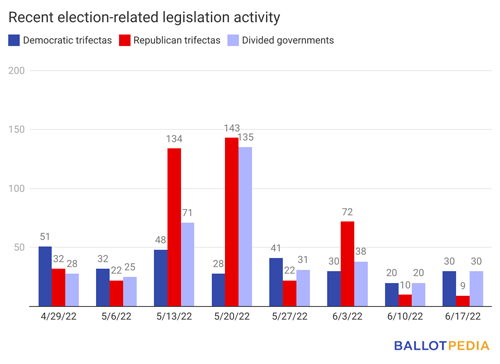
- 22 bills were either introduced or saw pre-committee action (e.g., new sponsor added, subcommittee hearing scheduled, etc.).
- Democratic trifectas: 3.
- Republican trifectas: 2.
- Divided governments: 17.
- 7 bills advanced from committee (or saw post-committee action).
- Democratic trifectas: 4.
- Divided governments: 3.
- 28 bills passed one chamber (or saw pre-adoption action in the second chamber).
- Democratic trifectas: 22.
- Republican trifectas: 1.
- Divided governments: 5.
- 8 bills passed both chambers (or were acted on in some way after passing both chambers).
- Republican trifectas: 6.
- Divided governments: 2.
- MI HB4996: Elections: special elections; special election to fill legislative vacancy; requires the governor to announce the dates to fill a vacancy in the legislature within 30 days of the vacancy. Amends secs. 178 & 634 of 1954 PA 116 (MCL 168.178 & 168.634).
- MI HB5287: Elections: political parties; references to city or township party committees in the Michigan election law; modify to county party committees. Amends secs. 370 & 719 of 1954 PA 116 (MCL 168.370 & 168.719).
- 2 bills were enacted.
- 2 bills died.
- Divided governments: 2.
The map below visualizes the concentration of this recent activity across the nation. A darker shade of yellow indicates a higher number of relevant bills that have been acted upon in the last week. A lighter shade of yellow indicates a lower number of bills that have been acted upon in the last week.
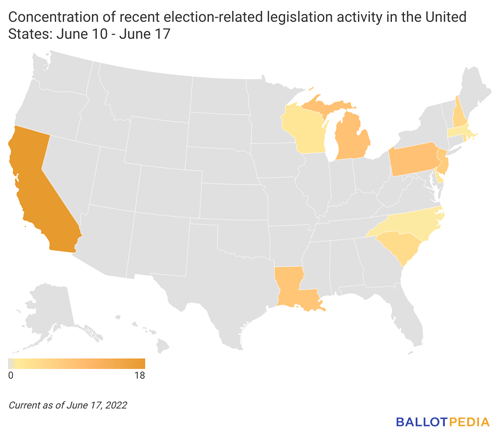
The big picture
To date, we have tracked 2,518 election-related bills. This represents a 0.5 percent increase as compared to last week’s 2,505 bills. These bills were either introduced this year or crossed over from last year’s legislative sessions.
Legislative status
The pie charts below visualize the legislative status of the bills we are tracking. The following status indicators are used:
- Introduced: The bill has been pre-filed, introduced, or referred to committee but has not otherwise been acted upon.
- Advanced from committee: The bill has received a favorable vote in committee. It has either advanced to another committee or to the floor for a vote.
- Passed one chamber: The bill has been approved by one legislative chamber.
- Conference committee: Differing versions of the bill have been approved by their respective chambers and a conference committee has been appointed to reconcile the differences.
- Passed both chambers: The bill has cleared both chambers of the legislature.
- Enacted: The bill has been enacted into law, by gubernatorial action or inaction or veto override.
- Vetoed: The bill has been vetoed.
- Dead: The bill has been defeated in committee or by floor vote.
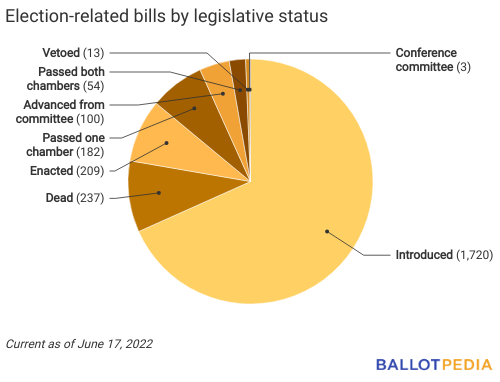
The pie charts below visualize the legislative status of bills in Democratic and Republican trifectas, respectively.
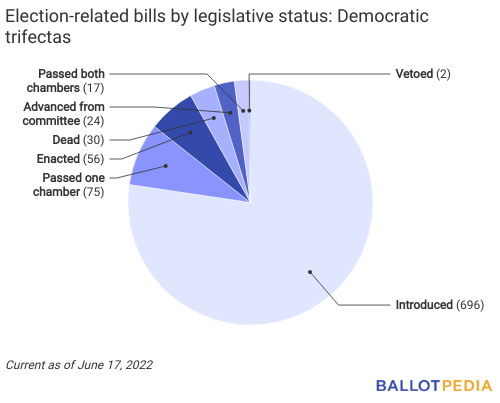
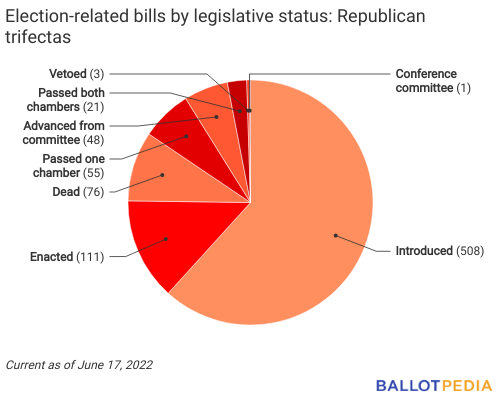
Concentration of activity
The map below visualizes the concentration of legislative activity across the nation. A darker shade of yellow indicates a higher number of relevant bills that have been introduced. A lighter shade of yellow indicates a lower number of relevant bills.
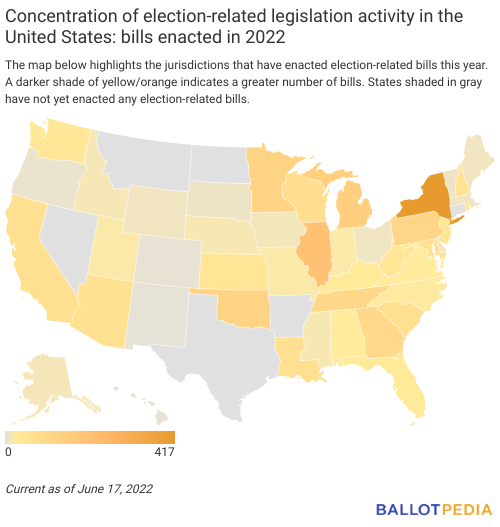
Partisan affiliation of sponsor(s)
The pie chart below visualizes the partisan affiliation of bill sponsors.
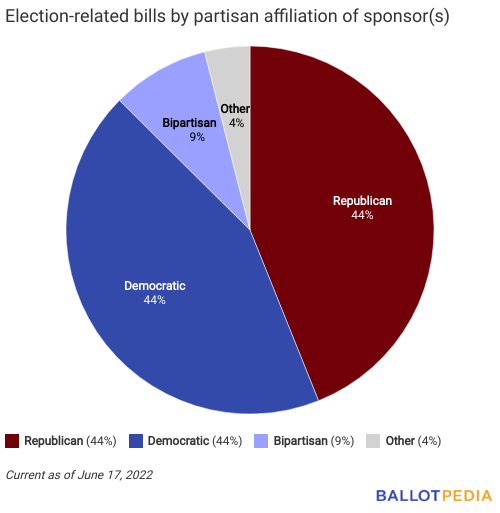
The bar chart below visualizes the correlation between the partisan affiliation of bill sponsors and trifecta status (e.g., how many Democratic-sponsored bills were introduced in Democratic trifectas vs. Republican trifectas).
